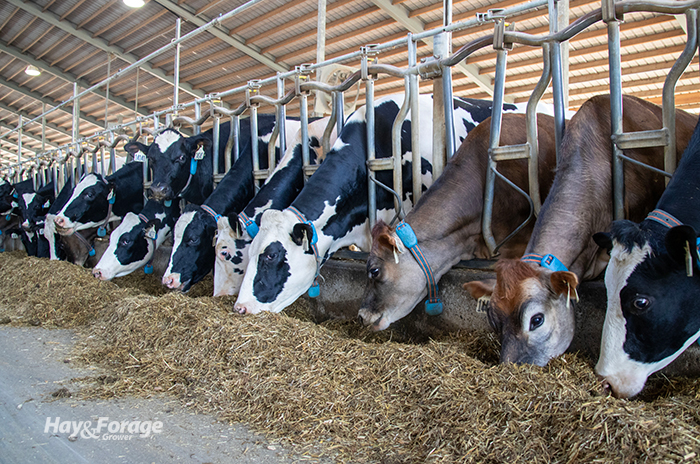
The futures market is shining a more promising light on milk prices for the second half of the year. Even with record high milk prices expected, though, the risk of weaker export sales, changes in domestic demand, and lower total milk production could interfere with those numbers moving forward.
No matter what milk prices are or predicted to be, maximizing income over feed costs on a dairy farm should be a top priority. However, when income is limited in this equation, there is more pressure to reduce feed costs and other on-farm expenses.
One of the most marvelous traits of dairy cattle is their ability to utilize fibrous forage for milk and meat production. It’s a trait that Thomas Kilcer states must be leveraged to achieve higher profit margins and better milk production in a recent issue of Crop Soil News.
The owner of Advanced Ag Systems, an agronomy consulting business based in Tennessee, suggests that raising forage inclusion rates in dairy rations is one solution to offset low milk prices and high commodity feed costs. The best way to make room in the diet for more forage is to ensure it has high quality — specifically high neutral detergent fiber digestibility (NDFD).
“Substituting highly digestible forage can help you meet the animal’s needs for high milk production without sending so much of your milk check to someone else,” Kilcer says.
These benefits are derived from improved feed intake and greater energy consumption. Kilcer notes research from Cornell University also shows that cows consuming rations with more highly digestible forage had fewer cases of mastitis and metabolic disorders. He contends healthier cows lead to smaller veterinarian bills, lower cull rates, and fewer retained heifers needed to maintain the herd size. All of these factors are reflected in better income over feed costs.
With that said, feeding more forage won’t be a quick fix. Farmers must first have the capacity to grow and/or store enough forage to boost their inclusion rates. Then, they may need to make changes to harvest or storage to capture and maintain forage quality. Assistance from a nutritionist will be required to carefully craft a new feeding plan and slowly transition cows to high-forage diets as well.
“Achieving the profitability of a high-forage diet takes two key people: the farmer who grows the forage and the nutritionist who balances the ration,” Kilcer says. “The nutritionist can only be as good as the forage they have to feed.”
Focus on fiber digestibility
The relative cost of nutrients in homegrown forage can be significantly less compared to that of concentrated feeds, but Kilcer notes high-forage diets will only offset expenses in the end if diligent harvest and storage management is carried out from the beginning. Delayed cutting, off-target moisture levels, and nutrient leaching in the windrow will sap potential cost savings as forage quality and fiber digestibility decline.
The drying process in particular is one that producers have limited control over. Even so, Kilcer recommends laying cut forage in wide swaths to minimize drying time, making swaths approximately 90% of the cutterbar length and aiming to chop forage in the same day.
Chop length will affect the physical effectiveness of highly digestible fiber as forage that is chopped too short can pass through the rumen too quickly. Therefore, Kilcer says chop length must increase as fiber digestibility does. A bigger particle size will slow down digestion and enhance nutrient availability.
“You can burn through a lot of highly digestible fiber without getting the nutrient benefits of forage if you chop it too short,” Kilcer asserts. “Adding a small amount of chopped straw to the ration will Band-Aid the issue, but the long-term answer is to increase the length of chop at harvest.”
Longer chop lengths for forages like winter triticale and forage sorghum have also been shown to reduce silage leachate. Kilcer notes these forages can generate 5 to 6 tons of biomass per acre, making it difficult to dry down to appropriate moisture levels for storage, and shorter chop lengths exacerbates this issue.
After haylage, corn silage is likely the other major component of high-forage dairy rations. Choosing corn varieties suited to your environment and harvest schedule will help ensure rations are properly balanced. Kilcer suggests selecting soft kernel varieties with more conservative maturity dates to target silage quality instead of maximizing yield. An earlier corn silage harvest also creates a wider window of opportunity to add winter annuals to the crop rotation that will further support homegrown forage supplies.
In terms of storage, Kilcer encourages producers to apply inoculants to haylage and corn silage. Doing so will not improve quality postharvest, but it can help maintain feed value over time.
Slow and steady
Any changes to harvest or processing must be relayed to the dairy’s nutritionists. Other aspects of the operation that may also be helpful to discuss include total acres, crop rotations, and storage site capacity. Being proactive will prevent miscommunication, which Kilcer has witnessed before.
“One farm was producing 60% haylage and 40% corn silage, which was the best rotation for their soil type,” he shares. “The nutritionist was feeding 60% corn silage and 40% haylage in the ration, and they were wondering why they were always running out of one of the feeds.”
Work with your nutritionist to make sure more forage is being introduced to diets slowly, raising inclusion rates by just 2% at a time and rebalancing rations after each step up. Kilcer notes animal performance may decline slightly once rations start to change, but feed intake, and thus milk production, should improve as animals adjust.
“Many dairy nutritionists have the skill, experience, and drive to meet your farm’s objective of feeding highly digestible forage,” Kilcer asserts. “If yours doesn’t, find one who will.”

